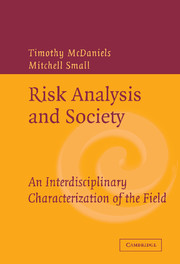Book contents
- Frontmatter
- Contents
- Contributors
- 1 Introduction – Risk Anaysis and Society: An Interdisciplinary Characterization of the Field
- PART ONE FUNDAMENTAL CHARACTER OF RISK
- PART TWO METHODS FOR RISK ASSESSMENT
- PART THREE NEW APPROACHES AND NEEDS FOR RISK MANAGEMENT
- 9 The Challenge of Integrating Deliberation and Expertise: Participation and Discourse in Risk Management
- 10 Global Change and Transboundary Risks
- 11 Environmental Risks and Developing Countries: An Asian Perspective
- SUMMARY AND FUTURE DIRECTIONS
- Index
- References
9 - The Challenge of Integrating Deliberation and Expertise: Participation and Discourse in Risk Management
Published online by Cambridge University Press: 05 June 2012
- Frontmatter
- Contents
- Contributors
- 1 Introduction – Risk Anaysis and Society: An Interdisciplinary Characterization of the Field
- PART ONE FUNDAMENTAL CHARACTER OF RISK
- PART TWO METHODS FOR RISK ASSESSMENT
- PART THREE NEW APPROACHES AND NEEDS FOR RISK MANAGEMENT
- 9 The Challenge of Integrating Deliberation and Expertise: Participation and Discourse in Risk Management
- 10 Global Change and Transboundary Risks
- 11 Environmental Risks and Developing Countries: An Asian Perspective
- SUMMARY AND FUTURE DIRECTIONS
- Index
- References
Summary
INTRODUCTION
The State Department of Environmental Protection was holding a public hearing in Lancaster, a small town in central Massachusetts, concerning the siting of a municipal waste incinerator (Renn and Webler, 1992, p. 84f., similar accounts in Freudenburg, 1983; Elliot, 1984; Davis, 1986; Brion, 1988; Rosa, 1988; positive examples in Lynn, 1987). The town hall was still nearly filled at 10:20 p.m., almost an hour after the scheduled closing time. For two hours residents listened peacefully while regulatory officials explained why the plant was needed, how much trash it would burn, and how much pollution it could legally emit. Expert scientists supported the officials by supplying evidence and arguments about the “acceptability” of the level of risk posed by an incinerator. The regulators thought they were being sensitive to the citizens when they kept to the agenda and, at 9:00 p.m., opened the floor for half an hour of questions. Now it was late, but the citizens were in an uproar, and they showed no sign of letting up.
“What about our gardens?” one woman asked, “Will we be able to eat the vegetables we grow? I have an organic garden and I don't want it contaminated with dioxin.” Another gentleman was interested in the contract. “Are you telling us that we have to sign a contract to supply 2,000 tons of trash every year? What if we want to start a recycling program?”
- Type
- Chapter
- Information
- Risk Analysis and SocietyAn Interdisciplinary Characterization of the Field, pp. 289 - 366Publisher: Cambridge University PressPrint publication year: 2003
References
- 17
- Cited by

